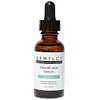What's inside
What's inside
 Key Ingredients
Key Ingredients

 Benefits
Benefits

 Concerns
Concerns

No concerns
 Ingredients Side-by-side
Ingredients Side-by-side

Water
Skin ConditioningGlycerin
HumectantNiacinamide
SmoothingSodium Chondroitin Sulfate
Skin ConditioningMethylglucoside Phosphate
Skin ConditioningCopper Lysinate/Prolinate
Skin ConditioningGlycosaminoglycans
EmollientBambusa Vulgaris Leaf/Stem Extract
HumectantPisum Sativum Extract
Skin ConditioningGlucosamine Hcl
Sodium Hyaluronate
HumectantPanthenol
Skin ConditioningPhenoxyethanol
PreservativeEthylhexylglycerin
Skin ConditioningPolysorbate 20
EmulsifyingDisodium EDTA
Water, Glycerin, Niacinamide, Sodium Chondroitin Sulfate, Methylglucoside Phosphate, Copper Lysinate/Prolinate, Glycosaminoglycans, Bambusa Vulgaris Leaf/Stem Extract, Pisum Sativum Extract, Glucosamine Hcl, Sodium Hyaluronate, Panthenol, Phenoxyethanol, Ethylhexylglycerin, Polysorbate 20, Disodium EDTA
Water
Skin ConditioningPerfluorohexane
SolventPerfluoroperhydrophenanthrene
Skin ConditioningButyrospermum Parkii Butter
Skin ConditioningPerfluorodecalin
Skin ConditioningC12-16 Alcohols
EmollientButylene Glycol Dicaprylate/Dicaprate
EmollientPolymethyl Methacrylate
Sodium Acrylates Copolymer
Glycerin
HumectantIsopropyl Palmitate
EmollientMethyl Methacrylate Crosspolymer
Adenosine
Skin ConditioningTocopherol
AntioxidantRicinus Communis Seed Oil
MaskingLavandula Angustifolia Flower Extract
CleansingAnthemis Nobilis Flower Oil
MaskingMagnesium Gluconate
Skin ConditioningProlinamidoethyl Imidazole
Skin ProtectingButylene Glycol
HumectantGlutamylamidoethyl Imidazole
Palmitoyl Hexapeptide-52
Skin ConditioningPolyvinyl Alcohol
Lactic Acid
BufferingGlycolic Acid
BufferingPalmitoyl Heptapeptide-18
Skin ConditioningHydrogenated Lecithin
EmulsifyingPalmitic Acid
EmollientSodium Cocoyl Glutamate
CleansingGlyceryl Stearate
EmollientStearic Acid
CleansingCetearyl Alcohol
EmollientLecithin
EmollientPhenoxyethanol
PreservativeEthylhexylglycerin
Skin ConditioningSodium Hydroxide
BufferingGlyceryl Caprylate
EmollientMenthone Glycerin Acetal
RefreshingP-Anisic Acid
MaskingCitric Acid
BufferingXanthan Gum
EmulsifyingHydroxyethylcellulose
Emulsion StabilisingHelianthus Annuus Seed Oil
EmollientChlorphenesin
AntimicrobialSodium Phytate
Silanediol Salicylate
EmollientTromethamine
BufferingMethylpropanediol
SolventLinalool
PerfumingWater, Perfluorohexane, Perfluoroperhydrophenanthrene, Butyrospermum Parkii Butter, Perfluorodecalin, C12-16 Alcohols, Butylene Glycol Dicaprylate/Dicaprate, Polymethyl Methacrylate, Sodium Acrylates Copolymer, Glycerin, Isopropyl Palmitate, Methyl Methacrylate Crosspolymer, Adenosine, Tocopherol, Ricinus Communis Seed Oil, Lavandula Angustifolia Flower Extract, Anthemis Nobilis Flower Oil, Magnesium Gluconate, Prolinamidoethyl Imidazole, Butylene Glycol, Glutamylamidoethyl Imidazole, Palmitoyl Hexapeptide-52, Polyvinyl Alcohol, Lactic Acid, Glycolic Acid, Palmitoyl Heptapeptide-18, Hydrogenated Lecithin, Palmitic Acid, Sodium Cocoyl Glutamate, Glyceryl Stearate, Stearic Acid, Cetearyl Alcohol, Lecithin, Phenoxyethanol, Ethylhexylglycerin, Sodium Hydroxide, Glyceryl Caprylate, Menthone Glycerin Acetal, P-Anisic Acid, Citric Acid, Xanthan Gum, Hydroxyethylcellulose, Helianthus Annuus Seed Oil, Chlorphenesin, Sodium Phytate, Silanediol Salicylate, Tromethamine, Methylpropanediol, Linalool
 Reviews
Reviews

Ingredients Explained
These ingredients are found in both products.
Ingredients higher up in an ingredient list are typically present in a larger amount.
Ethylhexylglycerin (we can't pronounce this either) is commonly used as a preservative and skin softener. It is derived from glyceryl.
You might see Ethylhexylglycerin often paired with other preservatives such as phenoxyethanol. Ethylhexylglycerin has been found to increase the effectiveness of these other preservatives.
Glycerin is already naturally found in your skin. It helps moisturize and protect your skin.
A study from 2016 found glycerin to be more effective as a humectant than AHAs and hyaluronic acid.
As a humectant, it helps the skin stay hydrated by pulling moisture to your skin. The low molecular weight of glycerin allows it to pull moisture into the deeper layers of your skin.
Hydrated skin improves your skin barrier; Your skin barrier helps protect against irritants and bacteria.
Glycerin has also been found to have antimicrobial and antiviral properties. Due to these properties, glycerin is often used in wound and burn treatments.
In cosmetics, glycerin is usually derived from plants such as soybean or palm. However, it can also be sourced from animals, such as tallow or animal fat.
This ingredient is organic, colorless, odorless, and non-toxic.
Glycerin is the name for this ingredient in American English. British English uses Glycerol/Glycerine.
Learn more about GlycerinPhenoxyethanol is a preservative that has germicide, antimicrobial, and aromatic properties. Studies show that phenoxyethanol can prevent microbial growth. By itself, it has a scent that is similar to that of a rose.
It's often used in formulations along with Caprylyl Glycol to preserve the shelf life of products.
Water. It's the most common cosmetic ingredient of all. You'll usually see it at the top of ingredient lists, meaning that it makes up the largest part of the product.
So why is it so popular? Water most often acts as a solvent - this means that it helps dissolve other ingredients into the formulation.
You'll also recognize water as that liquid we all need to stay alive. If you see this, drink a glass of water. Stay hydrated!
Learn more about Water